HARDWARE AND SOFTWARE
DEFINITION
PARTS OF COMPUTER
HARDWARE
SOFTWARE
DEFINITION
SOFTWARE
THE PHYSICAL PART OF THE COMPUTER AND THE ELEMENTS CONNECTED TO IT
HARDWARE
PROGRAMS,INSTRUCTIONS, APPS...
COMPUTER HARDWARE
MOTHERBOARD
Is the largest card with a printed circuit you see when you open a computer.
All the other computer com-
ponents are inserted
Includes connectors or communication ports with peripherals and can also incor-
porate video, audio and network devices, among others, depending on the characteristics of the computer.
PARTS
PCI SLOTS
PCI-E SLOTS
SATA CONNECTIONS
EXTERNAL COPNNECTIONS
BIOS BATTERY
MICROPROCESSOR SOCKET
CHIPSET
MEMORY SLOTS
POWER SUPPLY CONNECTION
IDE CONNECTION
MICROPROCESOR
The most important part of the computer
It is responsible for
processing data, performing arithmetical-logical operations and controlling all the
other devices
Is characterised by its working frequency, measured in hertz, which
determines its operating speed.
A modern computer may have a 5 GHz processor, which means it can perform
5 billion basic operations every second
The main microprocessor manufacturers are Intel and AMD.
HARDWARE AND SOFTWARE (LEARN)
THE MAIN COMPONENTS OF THE MOTHERBOARD
Microprocessor
socket
Is plugged in here. When you open the com-
puter, what you normally see is a large fan with an aluminium heat
sink below it. A thermal paste is added under the sink to improve
heat dispersal and, finally, the microprocessor is located above the
socket.
Chipset
This is a set of chips on the motherboard that carries out communi-
cations between the microprocessor and the different components
connected to the motherboard. It controls the operating mode of
the board and determines its performance and characteristics. The
most important chip normally has an aluminium heat sink above
it, smaller than the microprocessor.
RAM memory slots
RAM memory modules are plugged into these. These differ from
other slots in that they include clips to hold the module in place
and in that there may be empty slots but there will always be a
RAM module inserted.
ATX connector
This connector joins the power supply to the motherboard through
cables, as shown in the picture. It requires sufficient power to work.
IDE and SATA connections
These are the connections for the storage units: the hard disk, the
DVD-ROM, the DVD recorder, etc. The boards can have two types
of connection, IDE or SATA, or just one, depending on the age of
the computer. SATA connections are the more modern ones. The
picture shows the SATA (red) and IDE (blue) cables that connect the
motherboard to the storage units.
Expansion slots
These are for inserting expansion cards, such as the graphics card,
sound card, network card, etc. These cards are sometimes integrat-
ed into the motherboard so the slots might be empty. There are
various types: PCI, AGP and PCI Express (PCI-E).
External
connections
These are ports for connecting to the network (RJ45) and external
devices, such as the keyboard (purple PS2), the mouse (green PS2),
headphones (audio jacks), USB memory cards, etc.
Chip and battery
for BIOS
The BIOS is an integrated circuit that stores the computer booting
program. It can normally be distinguished from others as it gen-
erally has the word BIOS written on it, as shown in the picture. To
prevent specific setup parameters from being deleted, the BIOS
requires a battery.
